In-Depth Course Review: Excel/VBA for Creative Problem Solving
A complete path to learn spreadsheets programming visually, with a friendly instructor to boot.
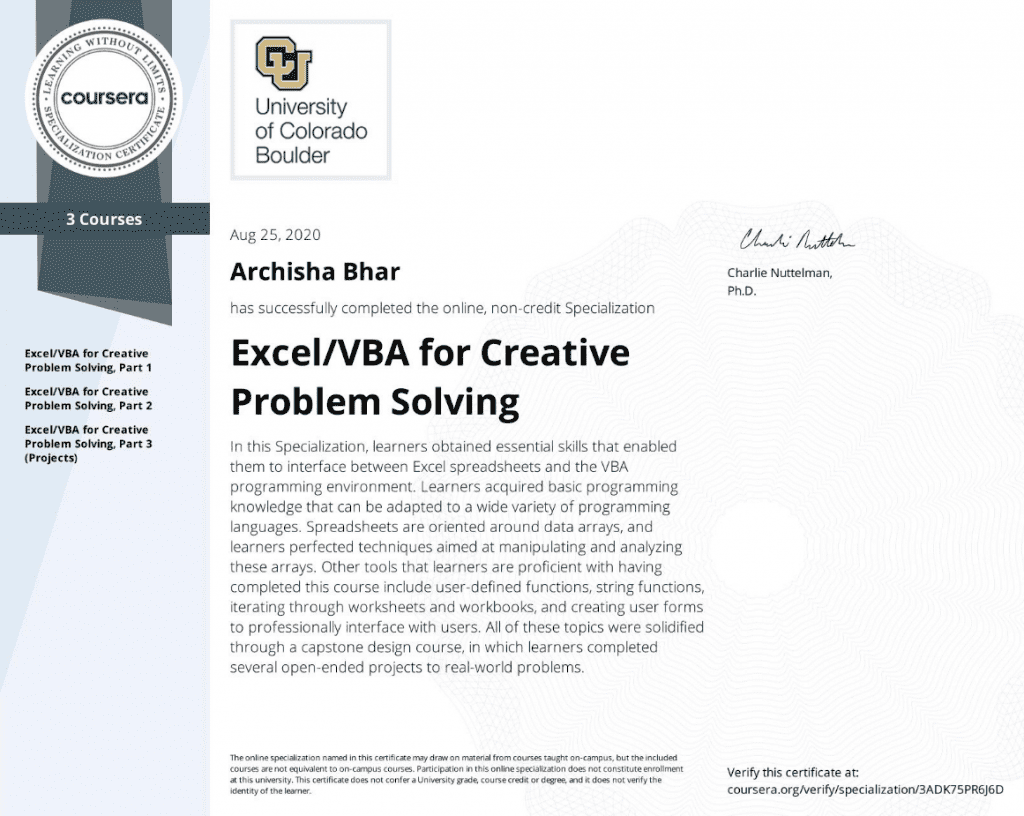
Excel/VBA for Creative Problem Solving is the first ever Course/Specialization I took on Excel/VBA. And I just didn’t need anything else! It’s a complete package. The instructor, Charlie Nuttelman, is super friendly and knowledgeable. He is one of the Top Instructors on Coursera, which totally makes sense.
What I learned from him, aside from Excel/VBA, is how much you need to have the basics clear in order to “excel” at anything. Many of us know a thing or two about Excel, but don’t realize there’s so much more that Excel can do. It was the same with me too. But after taking this Specialization, and also Parts 1 and Part 2 of Everyday Excel, I realized how much I had been missing all this time. And I also got a pretty good grip on VBA, thanks to the intensive projects of Part 3.

It is very important to not only learn and practice, but challenge your limits and learn on your own to solve actual, real-world problems. Many programming courses teach you the concepts and basic problems, but this Specialization actually makes you put your concepts to the test. As a Civil Engineering student, I found this really helpful.
After taking these courses, I’ve developed more confidence in using Excel and VBA. Whenever we are asked to do something in class using Excel, I know I can do it better than most and with confidence.
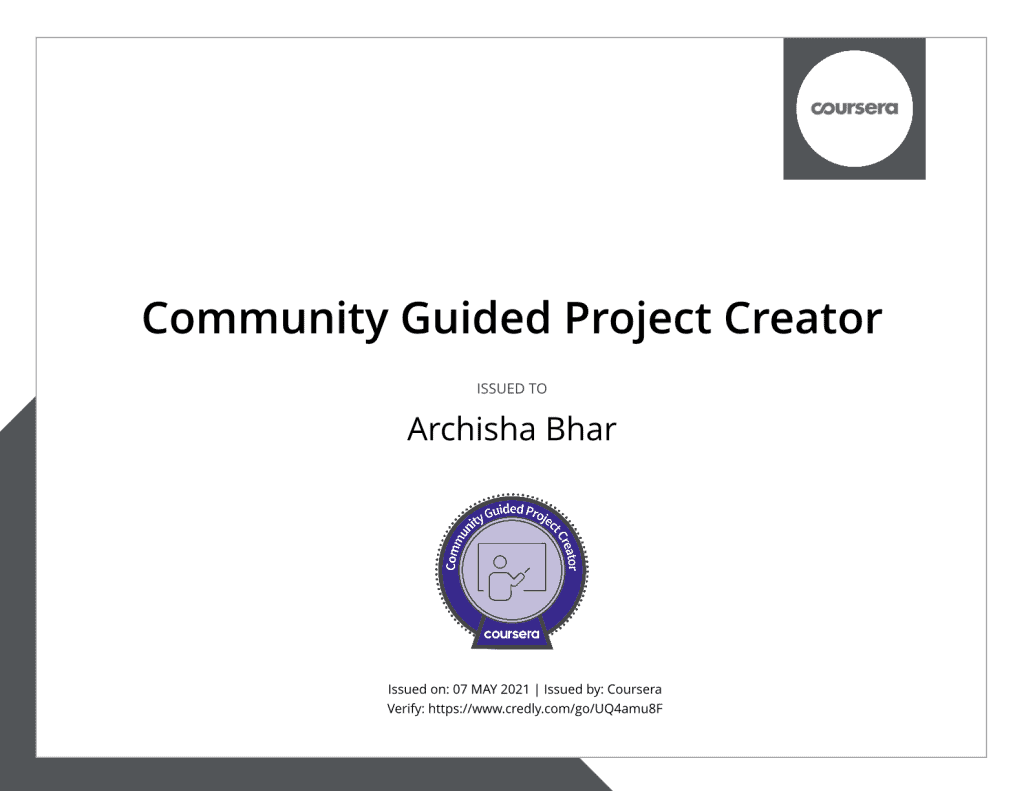
I would also like to mention here that I have a Guided Project on Coursera, Problem Solving using Microsoft Excel (it might be unavailable right now), and if I was able to create, it’s really thanks to Charlie Nuttelman. It was from his courses that I could learn Excel properly and actually make a Guided Project on Excel. I referred to his lessons, and included things that I learned from him. Without his courses, my Guided Project wouldn’t have been possible.
In October of 2021, Community Guided Projects were shut down. Class Central data shows that I had the second most popular Community Guided Project based on enrollments. When Coursera shut down Community Guided Projects, I was invited to create a course for the Coursera Project Network.
Excel can do more than you can possibly imagine, and VBA, with its powerful programming capabilities, lets you do even more. If you can successfully complete this Specialization, you will most likely be able to solve just about any problem on Excel/VBA. Onto my in-depth review!
Overview
Excel/VBA for Creative Problem Solving is a three-course Specialization offered by the University of Colorado Boulder. It is currently available for enrollment on Coursera. The Specialization aims to change the way one uses Excel spreadsheets by teaching how to automate and optimize spreadsheets using Visual Basics for Applications (VBA).
It has three courses: Part 1, Part 2, and Part 3. The first two courses teach learners the basics of VBA through video lectures, quizzes and in-application programming assignments. In Part 3, learners need to complete three “real world” projects, which will then be graded through peer review.
This is not a hardcore programming course. It is more of a problem-solving course where you’ll utilize computing techniques like VBA to solve real-world problems. Due to its visual nature, VBA makes learning programming easy even for those who have never programmed or solved problems using computer programs before.
On completion of the whole Specialization, you’ll get a separate certificate as well as the individual certificates for each of the three courses. So, four certificates in total. Of course, you’d still get the individual course certificates even if you don’t plan to take all the three courses.
Need to improve your Excel skills? Check out the Specialization, Everyday Excel, by the same instructor on Coursera. I took the first two courses and also found them very valuable.
Excel/VBA for Creative Problem Solving, Part 1
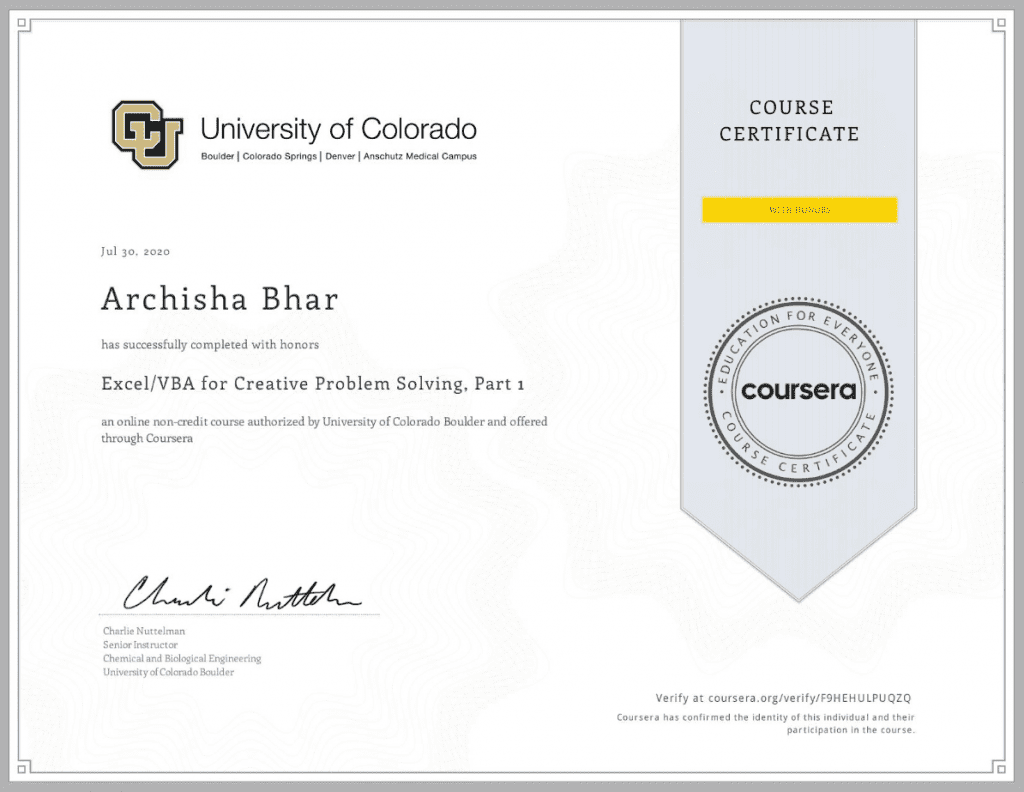
Excel/VBA for Creative Problem Solving, Part 1 teaches us to increase the efficiency with Excel by using the powerful programming and customizing abilities of VBA.
This course covers the following topics in each week:
- Create macros to automate procedures in Excel
- Define user-defined functions
- Create basic subroutines to interface with the user
- Learn the basic programming structures in VBA
- Automate Excel’s Goal Seek and Solver tools and use numerical techniques to create “live solutions” to solve targeting and optimization problems.
The course starts at a very basic level and gradually builds up in-depth topics. It is very detailed and minutely presents the many capabilities of Excel VBA.
Each week has dozens of excellent screencasts. Then there is a quiz that you must pass in order to unlock its solutions and a succeeding programming assignment. Assignment previews and instructions are neatly described by the instructor. These programming assignments are “in-application”, which means you’ll try to find out the solution on your own computer by simply downloading the assignment file. Once you pass it, you’ll be given a secret code which you have to put in the next quiz to pass. Pretty interesting, right!
There are also Discussion Forums for each week where you can share your thoughts with your fellow learners.
Week 5 of this course is special because if you pass the assignments, you’ll get a nice Honors designation on your certificate. This week is optional, but if you want to up your skills and earn an extra credential, you should definitely go for it. Here, you’ll learn some special Excel tools like Goal Seek and Solver, and use those to solve real-world problems on your own.
Excel/VBA for Creative Problem Solving, Part 2
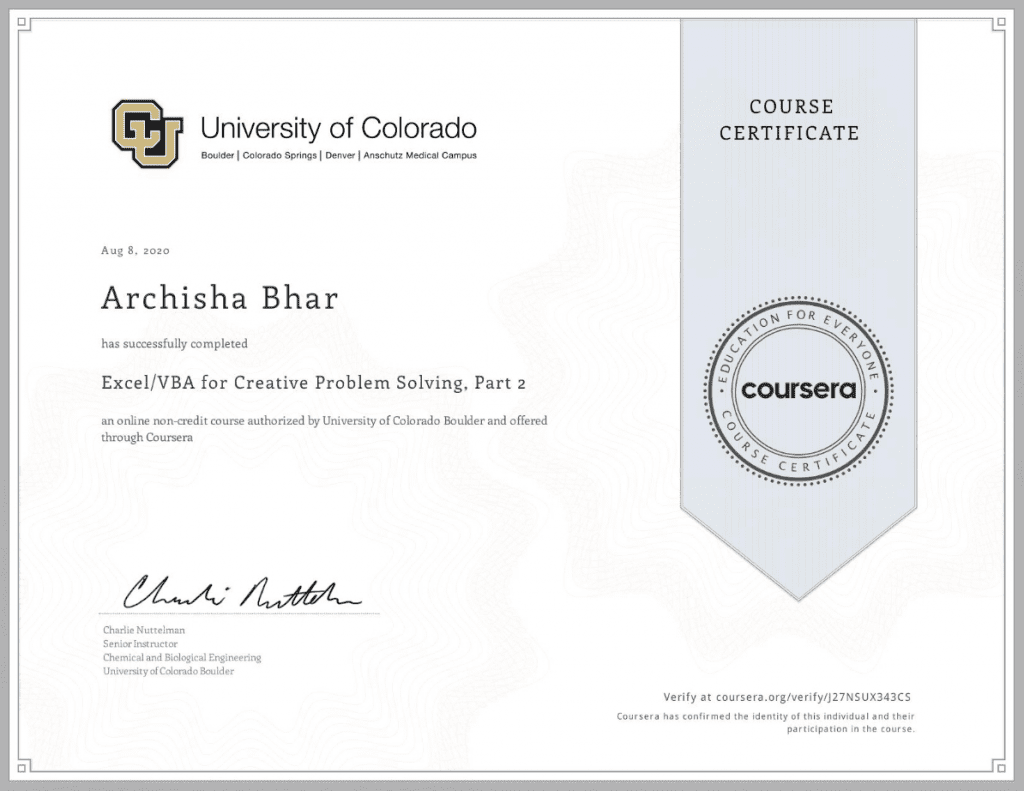
Excel/VBA for Creative Problem Solving, Part 2 introduces foundational and broad problems inspired by situations that we might encounter in the real world.
This course covers the following topics in each week:
- Learn how to work with arrays and import/export arrays from/to Excel using VBA code
- Learn how to work with text strings and write data to .txt files and import information from .txt files
- Automate the import, modification, and consolidation of information from multiple worksheets into a central worksheet as well as the import of information from multiple workbooks to a central workbook
- Gain experience with creating professional user forms to interface with the user, perform advanced calculations, and manipulate data on the spreadsheet.
If you have a foundational understanding of VBA code and programming structures, you can jump right into Part 2 without taking Part 1, and use the screencasts in Part 1 as reference.
Just like Part 1, Part 2 also has excellent screencasts, and requires you to pass a quiz and complete a problem-solving assignment in each module. These assignments are also “in-application”, which I think is a unique feature of this Specialization. It’s the same as Part 1. It also has Discussion Forums for each week where you can discuss ideas with your course-mates. But this part does not have the optional Honors week.
Excel/VBA for Creative Problem Solving, Part 3 (Projects)
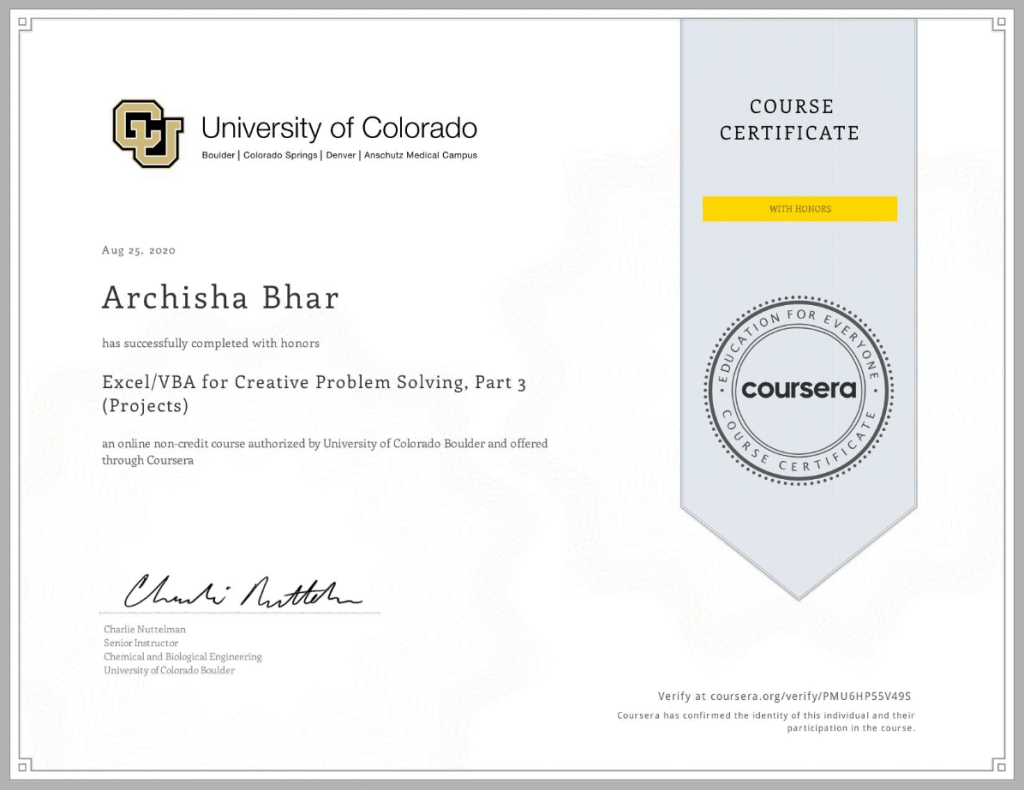
Excel/VBA for Creative Problem Solving, Part 3 is easier to describe than to take. It is highly recommended that you first take Part 1 and Part 2. This course builds off skills learned in those two courses.
Part 3 is a project-based course where you’ll be given challenging, real-world projects that you’ll have to build in Excel/VBA. But don’t worry! The instructor has part-by-part explanatory screencasts for each project. These are only to get you started, and you’ll have to complete the rest of the project on your own. But if you follow his videos and hints carefully, you’ll surely get to the full solution without any trouble.
The four compulsory weeks of this course require you to complete one project in each week, with each week having two projects to choose from. So, even if you’re not very sure about one topic, you can take the other one. The projects are quite open-ended and there are multiple ways to solve the problems.
This course also has the optional Week 5, where you’ll get an Honors designation on your certificate if you pass. This project can be very challenging, and you must have enough patience and perseverance to make it to the end. But thanks to the screencasts, it becomes a lot easier.
Grading is done through Peer Review where other learners will grade your project based on a grading rubric and vice-versa.
And finally, if you’re able to complete all the three parts of this Specialization, you’ll get a Specialization certificate! Mine’s at the top. If you plan to get one too, I hope you enjoy the courses.






